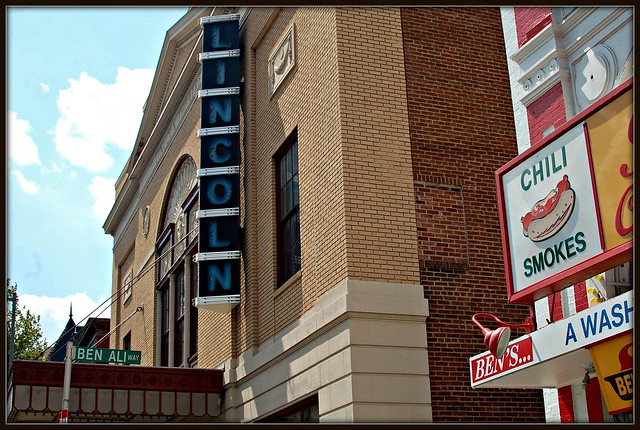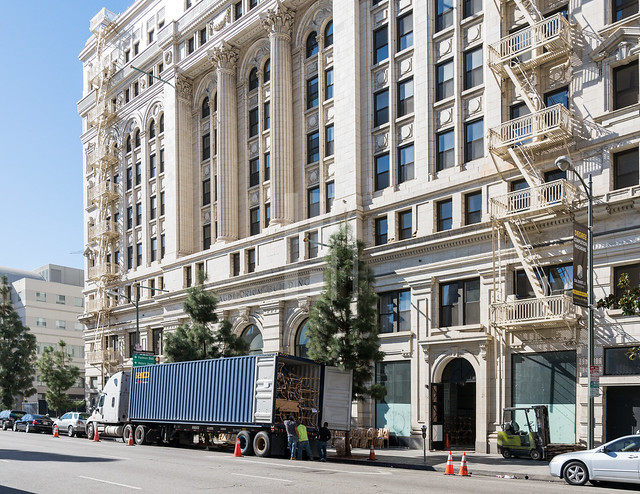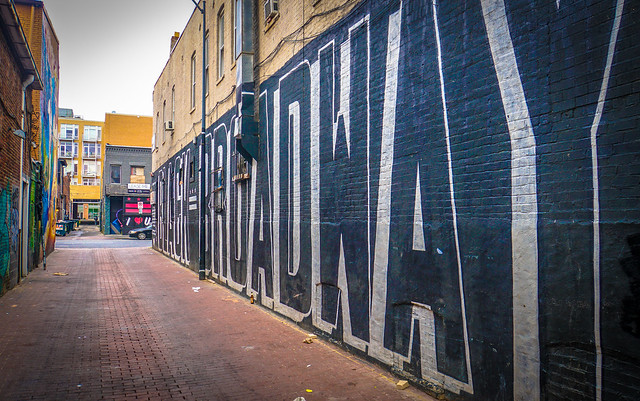Arunima Addy, Grant Davis and Berfin Evrim

Lincoln Theatre on “Black Broadway” in Washington, D.C. is a historical marker in a gentrified neighborhood. Image: BARPhotography
In September of 2018, The University of Texas at Austin released a new comprehensive study of gentrification in the city’s urban core. Austin, like many mid-sized cities around the country, has seen an increase in population over the past decade, as millennials seeking the benefits of urban living repopulate city centers. While an increase in upper-income residents has provided economic revitalization, it has also brought rising housing costs for lower income residents, many of whom have lived in the city for years.
Gentrification is not a new phenomenon, but with the rebirth of urban areas nationwide, it is occurring at an alarming rate. While an increase in housing costs is the most publicized problem, changing neighborhood dynamics cause more than just financial harm. When a neighborhood undergoes transformations through gentrification, culture is displaced and erased along with residents. As the original population moves out, the businesses, organizations, and institutions through which they socialized are no longer able to support themselves and often close or move elsewhere. The result is that the original residents’ culture and story can vanish. To the new residents of a gentrified neighborhood, the past life and character of the area may not even be visible. What results is an erasure we would like to call obliterated history.
In the following paragraphs, we argue that the cultural and constructed environments of historic neighborhoods should be maintained and nurtured. The power of heritage structures and spaces is their use as a learning tool and as a catalyst for community maintenance and growth.
The Importance of Architectural and Social History
Gentrification alters the narrative of a given place, yet a place’s history can be altered in other ways as well. We define the obliteration of history as the removal, editing, or concealment of a place’s history by either conscious or unconscious means. Historical narrative – the story of the events that occurred in a place – can be colored through bias and is framed through whoever is telling the story. In extreme examples, one side tries to obliterate a story, while another tries to salvage it, depending on who benefits from the story. Ultimately, historical narratives are structured through the tension between knowledge and power.
We propose three terms for classifying forms of historical obliteration, each varying in their method and application. Erasure is the first form, consisting of the coordinated effort to erase the presence of a building place or function. Retelling is the coordinated effort to alter the story of a place to fit a particular agenda. Negligence is the loss of a place’s history through a slow process of forgetting. Gentrification, it could be said, falls into the category of negligence, which is the most complex of the three. Identifying the specific reasons for negligence is often difficult, as it happens gradually over time, often with many groups involved. This incremental process may make it easy to consider gentrification and negligence as unavoidable processes. The negative results of both gentrification and negligence make it important for city planners and designers to critically consider their impact.
As society changes over time, we must ask ourselves whether the maintenance of a place’s story is a worthwhile endeavor. As scholars of architecture, we argue that the answer must be “yes”. A selection of academic research has identified the retention of a place’s history as beneficial, both as a tool for building community and for teaching history. Textbooks and news media often selectively omit (or “obliterate”) elements of a story. What is left out often causes as much controversy as what is included. Research shows architecture is no different, and the maintenance of even seemingly insignificant neighborhoods contributes to the composition of the story of a city and a people.
In the following sections, we will show examples where the relative consistency of a built environment allows it to unite people, educate them or facilitate an experience. For academics studying history and anthropology, architecture’s key position as a framework for life and society makes a case for keeping the built environment as robust and readable as possible. Physical space can provide us with insights beyond those of a textbook.
Japan Town in San Francisco is an example of a neighborhood with a visible heritage. Image: Chocksta
Legacy Neighborhood Preservation and Community Building
Popular belief maintains that historic preservation initiatives accelerate gentrification. Historic Preservation is thought to sacrifice community resilience and affordability on the altar of aesthetic maintenance. A recent study by James Buckley and Donna Graves suggests otherwise. They examine the challenge San Francisco has faced since the 1990s, as computer technology companies such as Google, Twitter, and Apple and the affluent workers they bring has driven up the price of real estate throughout the city. After a Historic Architecture Review Board appointed by the mayor was replaced with a board elected by the community, new historical designation solutions were enacted. The new resolutions helped not only in the preservation of existing buildings, they also helped longtime businesses and social groups ride out gentrification processes. The new focus is on promoting festivals, businesses, and legacy residents, not simply renewing bricks and mortar. Legacy business funds help to support businesses, which form the backbone of cultural heritage districts and solidify the history of the area for current and future generations.
Preservation Through Empowerment
On the other side of the globe, the two largest Israeli cities, Tel Aviv and Jerusalem, faced their own gentrification struggles starting in the 1990s. As increased population and tourism energized the two cities, developers were eager to build new developments and replace outdated housing stock. Seeking to minimize the environmental and urban disruption of massive new construction, the Israeli government implemented a program known as the Phoenix Strategy. This strategy relies heavily on the empowerment of existing residents (owners and renters) to make improvements to their spaces and structures rather than move or completely rebuild. Subsidized loans and legal assistance was provided to owner-occupants seeking to improve or enlarge their deteriorating 1950s-era housing. Renters occupying public housing or apartments were helped to purchase their homes rather than move, as economic conditions in the area improved and prices rose. This strategy prevented the disruption of neighborhood ties, and encouraged regeneration, while contributing to environmental goals by reusing structures rather than tearing them down. It also protected against the dislocation caused by gentrification through increasing resident ownership early in the neighborhood renewal process.
Architecture: A Physical Textbook
The strategic retention of legacy neighborhoods and structures has benefits beyond community preservation and resilience. Architectural preservation is sometimes seen as a means to re-create a building’s earlier condition – like restoring a painting in a museum – that gives us insights into life and society in the past. In her introductory essay for the March 2006 issue of The Journal of Architectural Historians, Nancy Stieber explores the educational power of architecture and the dialogue between architectural historians and scholars in other fields, such as anthropology. She argues, backed by her own experience and conversations with academic leaders, that buildings, even vernacular structures, create a useful mediator of cultural and social history due to the political and social processes by which they are created.
Citing Lizabeth Cohen, a social historian, Stieber explains how the physical study of architectural history benefits other academic fields. “The study of the built environment offers historians a unique opportunity to pursue a major preoccupation of our discipline,” Cohen states. Stieber further elaborates on the importance of preservation due to the intricate relationship between the constructed environment and issues of cultural development, political legitimacy, and economic processes. For Stieber and other social and historical professionals, the built environment is a potent primary resource for the study and understanding of past civilizations and cultures.
The Embassy Auditorium: A Catalyst for 20th Latina and Progressive Movements. Image: Hunter Kerhart
The Embassy Auditorium in Los Angeles
Author and urban studies professor Dolores Hayden, in her 1997 book The Power of Place, analyzes the efforts of her non-profit organization of the same name to preserve the structure of the Embassy Auditorium in Los Angeles and renovate it to serve as an education center and reading room. The auditorium, originally part of a church complex and designed in the Beaux Arts style, played an important role as the main host of garment workers union rallies in the mid 20th century. In an era riddled with racially charged urban and economic policies as well as anti-progressive McCarthyism, the Embassy Auditorium was one of few havens for Latino and workers’ rights movements. Prominent Latina union leaders Rose Pesotta, Luisa Moreno, and Josefina Fierro de Bright all organized rallies and meetings at the Embassy Auditorium during the 1940s and 50s. In the early 1990s, Hayden’s non-profit organization advocated for the establishment of a reading room for historical documents relating to union activities as well as a permanent installation outside the building entrance. They cited the double benefit of preserving the space as an educational center as well as a prominent example of Beaux Arts Architecture in Los Angeles. Sadly, the sale of the building by USC halted the plans, but nonetheless, the effort exhibited the credence of architecture as a tool for learning about history.
“The Return of Black Broadway” Mural by Cory Stowers. Image: Ted Eytan
Lost Neighborhoods and the Complexities of Historical Designation
Black Broadway, a primarily middle-class African American neighborhood and entertainment hub in Washington, D.C., faced a danger of erasure after the assassination of Martin Luther King Jr. in 1968. The community was self-sufficient, with a variety of community facilities such as doctors, lawyers, retail, banks and restaurants. It was a lively place that hosted numerous public figures such as Sam Cooke and even Fidel Castro. Historical reports spoke of music on the streets day and night, giving the area a vivacious identity of its own.
The area faced its downfall with the political disruptions after the 1968 assassination of Martin Luther King Jr. As riots in African American communities increased after King’s assassination, business owners were faced with losing their clientele and many moved out of the area. As historic buildings were shuttered and torn down, “Black Broadway” saw many of its landmark monuments eroded. The local historical society also faced difficulties in halting this trend.
After the riots of the 1970s, only a few of the legacy businesses returned in the 1980s to early 1990s. Because of negligence and the tarnished reputation caused by the 1970s violence, policy makers did not give much importance to the loss of the area’s African American identity. With successive openings of the Metro Green Line from 1991-2001, the area became better connected to downtown Washington. The result was a construction boom of high-end apartment buildings that brought gentrification and new development to Black Broadway.
Amidst the high-rises, one can still identify some of the remnants of African-American businesses and relics of Black Broadway’s bountiful past. The remaining structures still celebrate African-American success, with artifacts depicting local Black historical figures.One structure remaining from Black Broadway’s earlier era is Ben’s Chili Bowl, which opened in 1958, survived the violence of the riots, and continued operating for years afterwards.
It is through these retained legacy businesses that the oral and experiential history of Black Broadway has been maintained. These legacy spaces provide a physical environment for conversations that help transmit the history of a neighborhood to new residents who may have little understanding of it otherwise. This illustrates the power of the built environment, not only as a visual learning tool but also as a tool for oral history.
The Pros and Cons of Historical Designation for Legacy Neighborhoods
While the examples taken from San Francisco, Tel Aviv, Jerusalem, and Los Angeles demonstrate the successes of community preservation and the importance of maintaining architecture as an educational tool, the example of Black Broadway, where all but a few legacy businesses and buildings were lost, illustrates a less successful situation.
Anthropologist Michael Herzfeld argues that historical preservation movements have been hijacked by neoliberal agendas that take advantage of preservation tax remission to fund gentrification by inducing renovation and development. In his 2010 article for Current Anthropology, he asserts that preservation is seen as an ethical good that cements a historical narrative while sometimes ignoring current-day users. For Herzfeld, historical preservation provides an excuse for policymakers to intervene in urban life in a way that advantages a limited range of benefactors under the guise of common good.
N. Edward Coulson and Robin Leichenko counter Herzfeld’s position in a 2004 article that examines demographic shifts in downtown Fort Worth, Texas from 1990-2000, following the area’s historical designation. Their research found that few demographic shifts took place in the area after its historical designation. Owner-occupancy rates were also minimally affected. They noted, however, that designation as a historical district brought across-the-board increases in property value. They conclude that designation as a historical area is not in and of itself powerful enough to trigger gentrification, but that factors such as desirable location and economic conditions are greater indicators of potential development. We see the same phenomenon taking place in the Black Broadway example, where most legacy institutions were lost before the area received its historical designation. Displacement of legacy tenants was driven largely by increased housing demand and a newly accessible location. In the Black Broadway example, historical designation has been beneficial to the remaining older businesses, as it has provided resources to allow the few remaining legacy businesses to continue operation.
Conclusions
Urban regeneration, reinvestment, and gentrification have transformed the original character of places and re-written the narratives of their social and cultural contexts. We argue that given the benefits of preserved communities to residents, as well as their advantage as a historical tool, it is time for the public to examine urban regeneration with a more critical eye. In the cases we have presented, carefully thought-out and inclusive historical designation practices which respected legacy businesses and sought subsidies for existing residents helped maintain an area’s cultural and aesthetic qualities. We agree with Stieber’s assessment that architecture serves as a profound primary resource for historians, centuries after all human witnesses are lost. The way in which we read buildings, aesthetically and contextually, allows us to understand what humanity was and what it may become. Equipped with the knowledge of these possibilities, we, as architects and as citizens, must ask ourselves if we will continue to tolerate the negligent erasure of cultural heritage. Will we use the tools and methods available to us to create resilient neighborhoods that will allow the regeneration of urban centers? We suggest that we can and we should.
References:
Buckley, James Michael, and Donna Graves. “Tangible Benefits From Intangible Resources: Using Social and Cultural History to Plan Neighborhood Futures.” Journal of the American Planning Association 82, no. 2 (Spring 2016): 152–66. doi:10.1080/01944363.2016.1141663.
Carmon, Naomi. 2002. “The Phoenix Strategy for Updating Housing Stock: Preventing Neighborhood Deterioration and Promoting Sustainable Development.” American Planning Association.Journal of the American Planning Association 68 (4) (Autumn): 416-434. doi:http://dx.doi.org/10.1080/01944360208976283.
Coulson, N. Edward, and Robin M. Leichenko. “Historic Preservation and Neighborhood Change.” Urban Studies 41, no. 8 (July 2004). Accessed November 25, 2018.
Desai, Madhuri. “Mosques, temples, and orientalists: Hegemonic imaginations in Banaras.” Traditional Dwellings and Settlements Review (2003): 23-37.
Hayden, Dolores. The Power of Place. 191-209. Cambridge, MA: MIT Press, 1997.
Herzfeld, Michael. “Engagement, Gentrification, and the Neoliberal Hijacking of History.” Current Anthropology 51, no. S2 (2010): S259-267. doi:10.1086/653420.
Kaplan, Sarah. “The voices of U Street’s ‘Black Broadway’ days are fading. Time to hit record” The Washington Post, Aug 27, 2014.
Stieber, Nancy. “Introduction.” Journal of the Society of Architectural Historians 65, no. 1 (2006): 5-6. doi:10.2307/25068224.
Thomas, Briana. “The Forgotten History of U Street.” Washingtonian. April 06, 2017. .Accessed September 30,2018.
Way, Heather, Elizabeth Mueller, and Jake Wegmann. Uprooted: Residential Displacement in Austin’s Gentrifying Neighborhoods and What Can Be Done About It. Report. The Center for Sustainable Development, The University of Texas at Austin. 2018.


